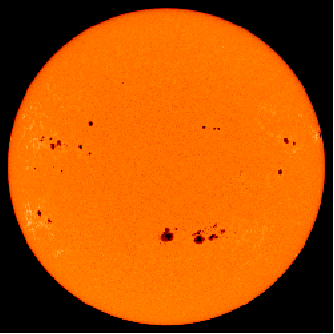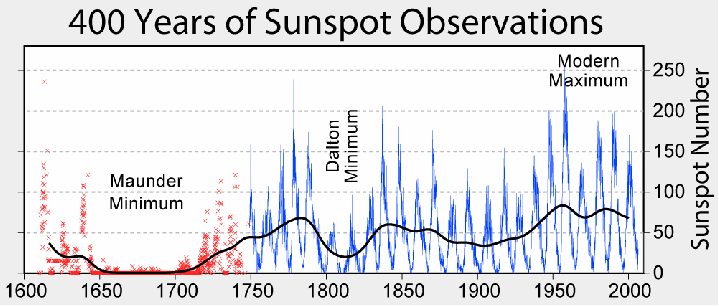Sunspots are magnetic disturbances on the surface of the Sun slightly lower in temperature (about 3000 – 4500 K compared to an average surface temperature of about 5780 K) so darker, than surrounding areas. They usually appear as pairs, each of opposite magnetic polarity.

Sunspots expand and contract as they move across the Sun;s and can vary from 16 km to 160,000 km, and may move at speeds of several hundreds of meters per second. They are responsible for spectacular coronal loops of gas and ejections of mass into space.
Sunspots occur as apart of a cycle, called the solar cycle. Every 11 years or so the activity of the Sun increases to a maximum then decreases. The point of highest sunspot activity during this cycle is known as Solar Maximum, and the point of lowest activity is Solar Minimum. Early in the cycle, sunspots appear in the higher latitudes and then move towards the equator as the cycle approaches maximum. Geological studies have suggested that the solar cycles have been active for hundreds of millions of years at least. The diagram below is our best estimate of sunspot numbers over the pas 400 years. Notice the Maunder minimum, which coincided with 'little ice age'.

In 1908, the American George Hale used a modified spectroheliograph to show that the spectra of hydrogen exhibited the Zeeman effect whenever the area of view passed over a sunspot on the solar disc, indicating that sunspots were magnetic phenomena.] Subsequent work by Hale demonstrated a strong tendency for east-west alignment of magnetic polarities in sunspots, with mirror symmetry across the solar equator; and that the magnetic polarity for sunspots in each hemisphere switched orientation, from one sunspot cycle to the next.
It is believed sunspots are caused by magnetic flux tubes in the Sun's convective zone becoming wound up and twisted because the rotation rate of the Sun is not constant but varies with latitude. If the stress on the tubes rexcides a point they twist and puncture the Sun's surface. Convection is inhibited at the puncture points; the energy flux from the Sun's interior decreases; and with it surface temperature.
A sunspot is actually a depression in the Sun's surface. At the centre is the dark umbra, where the magnetic field is radially out from the Sun, and surrounding is the lighter penumbra where the magnetic field is more inclined.
Magnetic pressure should tend to weaken magnetic fields causing sunspots to disperse, but the lifetimes are too long for this to be the case. Three dimensional images made with sound waves show that there is a powerful downdraft underneath each sunspot, forming a rotating vortex that concentrates the magnetic field and creating a sort of magnetic hurricane to maintain the field.
